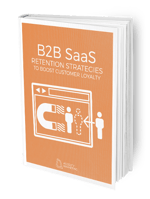CHAPTER 3: RETENTION
INTRODUCTION
Your B2B SaaS company may be focused on converting new leads and closing them into customers, but what are you doing to retain customers once they sign on?
You might have the best lead generation strategy in the industry, but you need to delight current customers and retain them in order to continue your business success.
Not sure where to start? Keep reading. This ebook will walk through multiple strategies for you to consider, test and implement. Use any number of these strategies to ensure that your B2B SaaS company’s customers keep coming back for more.
Want a PDF of the comprehensive guide? Download Now!
1. ONBOARD YOUR CLIENTS
This might seem obvious, but an effective onboarding program is one of the top things your company should provide customers. Doing so will boost utilization rates quickly. Onboarding programs are different for every B2B SaaS business. Consider the following strategies:
- Host a mix of online training and in-person training
- Share digital manuals and training videos to walk through your products
- Add in-product pop-ups that provide information on functionality and benefits when a new user logs in (think Microsoft’s Clippy)
- Gamify the process by sending users badges or other rewards when they complete tasks or go to certain areas within the product
There are many other ways to help new customers implement your tools. Consider your business capacity for onboarding and think about which company resources can be allocated to this process. Don’t forget to test different options and get feedback from current users.

2. PROVIDE HIGH-QUALITY CUSTOMER SUPPORT
Customer support is a must-have for B2B SaaS companies. While you may know your product like the back of your hand, your new customers are using it for the first time and will still need help after training. Even veteran customers need an occasional refresher, especially as you make updates to the product.
That being said, you need to have a customer support team that can guide them.
When building your customer support team, consider the following:
HOW OFTEN YOUR CUSTOMERS REACH OUT FOR HELP
Are you getting a downpour of customer issues or just a sprinkle here and there? Ensure your resources coordinate with your customer demands. Don’t over (or under) staff your team.
THE QUALITY OF YOUR SUPPORT TEAM
Quality support means different things to different people, so make sure your team is trained to properly handle potentially frustrated customers. Train your team on the ins and outs of the product so they are viewed by customers as a credible source.
HOW YOU HANDLE DIFFERENT TYPES OF ISSUES
Not all customer support issues are equal, therefore many SaaS companies have tiered systems. Support tiers ensure that quick, small issues are handled right away. Larger issues are handled by a trained support professional who can take care of the issue in a timely manner and set appropriate expectations.
HOW YOU MEASURE THE SUCCESS OF YOUR SUPPORT TEAM
You need to have a tangible metric for measuring customer support success. One great way to do that is through post-call customer surveys. These surveys are completed when a customer stays on the line after talking to a support rep to share how that rep did.
Some SaaS companies measure support success on a scale of 1-10, and set goals of where they’d like to score (typically, the goal is 9 or higher). Other B2B SaaS companies use the Net Promoter Score system to quantify success.
CUSTOMER TIME ZONES
Is your company local, regional, national or global? Make sure the availability of your support team matches the need for customers beyond your time zone.
3. CONTACT NEW USERS WHO HAVEN’T LOGGED IN
Stay on top of new customers to ensure utilization. The more a new customer uses your product, the more likely they are to continue using it and remain a customer.
To ensure utilization, enable your sales, service and/or training teams to access a list of users who haven’t logged in to, or used, your product, within the first two weeks (this timeframe may vary based on your customers).
Pull this list on a weekly, biweekly or monthly basis to catch low usage right away. Have a system in place to help users adopt the technology. This system could be:
- Having a support or training associate call to see if the user needs assistance
- Sending a video that notes the top three things new users can do to get started right away
- Setting up a weekly email campaign that outlines how to get the most out of the product right away
4. CHECK ON INACTIVE USERS
Remember, retention isn’t just about new users—you may also have veteran users who stopped utilizing your product. In the same way, you might run a list to find inactive new customers, pull a list every month of customers who haven’t logged in to your product in the past 30 days. The strategies to contact this group are similar, but not the same.
When you see a customer who isn’t using the product, you can:
- Have a support member or their sales rep reach out and take a temperature check. Ask for feedback and see if a recent update could be affecting the sudden drop in usage
- Send a survey to make sure the product is still meeting their needs as a user and company
- Invite them to a webinar to keep them in the know about new features (we cover this in #5!)
5. HOLD FREE USER WEBINARS
Webinars are a great (and inexpensive) way to build value with your users. Webinars can cover a variety of topics, and give your users an interactive outlet to connect with your business and other users.
Here are a few ideas of different webinars you can hold:

PRODUCT WEBINARS
This webinar reviews the high-level benefits, features and functionality of your product. This a great time to refresh current clients on all of your product’s capabilities.

UPDATES WEBINARS
Walk through any new features (and their benefits) in your product.

MAGNIFYING GLASS WEBINARS
Is your product robust? These webinars allow you to put a figurative magnifying glass over one aspect of your product, giving more detailed instruction on how to use a specific feature.

INDUSTRY WEBINARS
Provide value beyond your product by keeping your users in the know about the latest happenings in their industry. Invite a power user to speak during the webinar and discuss how your product helps them stay on top of industry changes.
6. CREATE A REFERRAL INCENTIVE PROGRAM
Referral programs with incentives help you grow your company by adding new users, while also retaining your current customers.
Set up an easy system for your business to receive referrals. Create a specific referral landing page where your customers can fill out a short form with the referral’s information. Encourage the customer to talk to the person ahead of time—this will make your reach out easier. Send the information of the person being referred to your sales team or manager to connect.
When it comes to referral rewards, make sure you manage expectations up front. A few examples of managing expectations include:
- Determining how often a customer can refer. Can your customers provide an unlimited amount of referrals? Are they limited to a monthly or yearly amount? Clarify this ahead of time.
- Defining what deserves a reward. Many companies incentivize customers based on how the referred person moves through the sales cycle. Will you reward a customer for simply providing a referral? Will you wait until that referral attends a meeting or demonstration with your business? Or will you only reward customers when their referrals buy your product? Decide what is most beneficial to your business and set guidelines from there.
- Deciding on the incentive. Some businesses enter their customers into gift card drawings. Others provide a certain dollar amount or percentage off of their customer’s subscription (up to a certain limit). Brainstorm which options drive the most referrals for your business. Before implementing your choice, make sure whatever option you pick is still profitable for your business.
The most important thing with a referral program is to keep communication lines open and remember, when referrals hit certain benchmarks, keep your promises to the referrer.
7. SURPRISE YOUR CLIENTS
Everyone likes a positive surprise. Give your clients something that delights them; this could be as simple as a free ebook about upcoming industry changes or a quick note on their birthday.
Do you have a tiered subscription program? Upgrade your clients to a higher subscription for a weekend, week or month for free, with no canceling requirements. Not only will this give them access to new product features, but it can also help you upsell.
Science shows people like unexpected surprises—it turns on the brain’s pleasure centers. Delight your clients on occasion and they will associate those positive feelings with your company.
8. UPSELL & CROSS SELL
Upselling and cross-selling are other important ways to retain your clients because they increase customer lifetime value. When you upsell and cross-sell to the right people with the right message, you build more meaningful relationships.
WHO ARE THE RIGHT PEOPLE?
When upselling and cross-selling, the right people are those who are happy with your customer service. They have few to no open cases with your support team and are actively using your product. In short, they are happy customers.
WHAT’S THE RIGHT MESSAGE FOR UPSELLING?
When you upsell, you’re taking someone from a lower level of your product at a lower price to a higher value-level of the product at a higher price. You need to focus on benefits and value. Talk to customers about their needs and listen to them to find out if the higher level will provide enough value. Are there things they need now that they currently do not get in their subscription? Find out, and talk through the benefits of upgrading to make their job easier.
WHAT’S THE RIGHT MESSAGE FOR CROSS-SELLING?
Cross-selling is a little different than upselling. With upselling, the customer has a need for your product, that’s why they bought it. An upsell explains why they need a higher level of that product. When cross-selling, you’re explaining why they need a completely different product that you also provide. That being said, building credibility at the business level is crucial. If the customer trusts your business, and you have a proven track record with them, it will make the cross-sell easier. Use these tips to boost your cross-selling wins:
- Make sure to pose the cross-sell as an opportunity
- Share with them that many of your other customers who use the product they use also use this other product
- Be consultative—make the message about helping them improve their business in other areas
- Position your message as a helpful tip, not a sales pitch

9. PERFORM REGULAR UPDATES & SHARE INFORMATION ABOUT THEM
B2B SaaS companies are in the business of innovating. This means you need to provide software updates regularly in order to meet the needs of your clients over time.
Bear in mind that updates for the sake of updates don’t provide value. Try to focus on two main areas of updates:
- Updates needed to make your SaaS more functional. This means updating software to remove bugs or to make the product easier to use.
- Updates that customers request or that are in demand by your industry.
It’s important to listen to what your customers want. However, that doesn’t mean you need to update the software based on every one-off request. Instead, survey and interview customers occasionally to hear out what the most prominent needs are while staying in-tune to industry demand. Then, prioritize your updates.
I MADE AN UPDATE. NOW WHAT?
Keep people in the know about the changes you’re making. Build excitement and increase transparency by letting customers know about updates before, during and after you make them. Try not to give any strict timelines about updates unless you can guarantee that you’ll stick to them.
Here are a few ways you can share information about your updates:
- Send emails sharing what the updates are. Use visuals when necessary.
- Hold a webinar to walk through updates and any new features.
- Use in-product pop-ups to walk customers through the updates the next time they log in to the product.
- Have your support team call any special cases (customers who generally need more help) to walk them step-by-step through any new updates.
- Share your updates on blogs, a press release or on social media (only do this for significant updates, not just bug fixes).
10. MEASURE NPS METRICS TO DISCOVER UNHAPPY CUSTOMERS
You need to know which customers are happy, but it’s also crucial to know which customers are unhappy. How can you discover which customers are less than pleased with your service? This can be fairly difficult because 96% of unhappy customers don’t complain.
So how do you break their silence? Using the NPS (net promoter score) survey is one way to find out which of your customers will refer you and which of your customers will tell others to avoid doing business with you.
How the NPS survey works:
- Send your customers a quarterly survey asking them one question: “How likely is it that you would recommend [your company] to a friend or colleague?” Use scoring from 0-10.
- Respondents that select 9 or 10 are promoters—they love your brand and they tell everyone about it, driving business growth.
- Respondents that select 7 or 8 are passives—they are satisfied, but not moved to refer your business. They can also be open to leaving your company for another.
- Those respondents that select 0-6 are detractors—they are unhappy customers that can slow your growth and spread negative feedback about your company.
- It’s crucial that you know who your detractors are so you can connect with them, delight them and move them on the path to becoming a promoter.
HOW TO BOOST SURVEY RESPONSES
Convincing people to take a short survey can be strangely difficult. If you have a hard time getting your customers to respond, try incentivizing the response. Offer to put them into a drawing for a $50 gift card or send every respondent a free item.
Just make sure that the gift has universal value. For example, don’t hold a drawing for a steak restaurant gift card if some of your customers are vegetarians. They may be less likely to take the survey, skewing your data.
11. NOTE WHO YOUR “SPONSORS” ARE AND FLAG WHEN THEY LEAVE
When a business initially signed on with you, it’s likely that there was one person there who believed in your product and pushed for their company to adopt your software. This person is called a “sponsor.” Make a note or mark this person in your CRM or other sales system and keep tabs on if and when this person leaves.
If this person leaves, hopefully, you’ve done everything you can to make sure others at the company adopt the software. It’s important to make sure that everything is running smoothly with this client.
However, the departure of the sponsor could mean everyone else who wasn’t previously bought into your product will start looking for another tool. To prevent this possibility when a sponsor leaves, watch the utilization rates of other users at the company. Also be sure to check in with other users to make sure they have everything they need to be successful.
12. GET BUY-IN BEYOND THE SPONSOR
As you just read in section #11, losing a company sponsor can be dangerous for retention rates. This means you need to get buy-in across a department or company and get it early. You can do this by:
- Sharing the benefits of your product early with decision makers and potential users.
- Providing guided trials that allow users to see the benefits for their company in a hands-on way.
- Offering thorough training to guarantee everyone at the company knows how to use the software.
- Dedicating a support team member or relationship manager to oversee their needs (depending on the size of the account).
- Watching user utilization rates and connecting with users who aren’t logged in to the product as much.

13. CONNECT OFTEN BEFORE SUBSCRIPTIONS END
This tip applies more to B2B SaaS companies who have long-term subscriptions (quarterly, annually or longer; not a monthly subscription). No matter how long your subscriptions are, they will eventually end. In order to retain those clients, connect with them often at the end of their subscription.
Start reaching out earlier than you’d think. If you have a year-long subscription, don’t wait until there are two weeks left in a client’s contract. Begin connecting at least a quarter before the subscription ends.
When you reach out:
- Find out if they have any questions or concerns about your product.
- Check usage logs to see if there has been a drop in log-ins.
- Review past support logs for any open or closed cases.
- Check marketing initiative data, like email sends, to see what information interests and engages them.
If necessary, use this information to create an action plan that improves the customer’s experience. This will give you a better chance of retaining them. If the customers are happy, use this information to inform future cross-selling and upselling opportunities.
14. WATCH YOUR SOCIAL PRESENCE AND WHAT PEOPLE ARE SAYING ABOUT YOU
This step is crucial for any business, and as a B2B SaaS company, you need to know what your users are saying about you. This means you should follow hashtags on Twitter and Facebook related to your product and company. You should also look at and engage with the comments, posts and shares people are directing at you.
Hopefully, most of the comments are positive, but at some point in the life of your company, you’ll probably see a negative comment. Craft a quick and human reply (i.e. don’t create a canned or robotic response) that lets them know you’re here to help. Offer them solutions to their problems. For example, you could tell them you’ll send them a message directly in the social platform to discuss the issue more in-depth.
Social engagement is a crucial retention factor. Share content that teaches your audience something new and interact with your customers’ posts to build rapport. While doing this, nip any negative chatter about your company in the bud and you will keep your clients happy.
15. MONITOR BILLING PROCESSES
Are some of your business customers paying by credit card while subscribing to a long-term contract? If so, chances are that some of those credit cards will expire during your relationship. Avoid sending them annoying emails telling them you haven’t received payment.
Instead, be proactive and monitor billing information (like credit card expiration dates) on the front end. That way, when their card expires, you can reach out once for the new information. Doing so helps you avoid annoying communication that could hurt your relationship.
16. PROVIDE VALUE OUTSIDE OF THE PRODUCT
In today’s consumer-driven culture, companies need to provide value in all aspects of a customer’s life. This starts while the customer is still a prospect and continues many years into the relationship.
What does this look like? Here are a few ideas:
- Provide free content that answers prospective client and current customer questions about their challenges and opportunities.
- Have your sales and support teams share relevant industry information with customers and prospects.
- Hold webinars worth continuing education credits.
There are many other ways to provide value to your customers. Start by talking to them about some of the things that would make their lives easier. Then, brainstorm ways to immediately add value in those areas.
17. FLAG CUSTOMERS WHO HAVE A LOT OF SUPPORT CASES
Every business has that customer who calls in constantly for support. Don’t treat these customers like hot potatoes! Have your support team flag customers with a lot of open support cases— these customers may be frustrated, lack training or just need more help in general.
Have a customer relationship manager connect with these flagged customers to talk through their needs. You may discover that they need more training or that there’s a bug in your software.
Regardless of what the underlying issue is, it’s better to roll up your sleeves with these customers and work with them towards a positive outcome.

18. MEET CUSTOMERS IN PERSON
B2B SaaS is a very impersonal industry because technology makes it easy to disconnect from the physical world. This is why it’s so crucial to remember that people buy from people. Even if you are the best or most high-tech company, remember that behind every email, every login and every phone call is a person.
You can humanize your company and build strong relationships by meeting your users face-to-face. This doesn’t mean you should travel to every one-person shop across the country. Prioritize your larger and more valuable accounts for in-person visits and make sure they receive the attention and training they need to stay successful and adopt your technology quickly.
19. HOLD CUSTOMER CONFERENCES & EVENTS
Holding a customer conference is a great way to let your customers understand who you are as a business. This is a great time to share why you do what you do to make their lives easier and let them meet your business leaders.
Customer conferences are also a prime time to share best practices about your product. Create times for your customers to interact with each other about their successes and places where they need help.
When setting up a customer conference, don’t make it all about you—it’s called a customer conference for a reason. Get feedback from your customers on what they’d like to learn about, share customer success stories and teach something new about their industry.
When holding the conference, reward your customer attendees. They took time out of their work schedule to travel and be at your event, after all. One way to do this is by sharing exclusive information that no one else knows about, like exciting new updates to your product. You could also hold a raffle for a $50 gift card, Amazon Alexa or another item that connects with your brand or conference message.
20. CREATE LINKEDIN USER GROUPS
Creating user groups is a great retention option, especially for small businesses that don’t have as many resources. When creating these groups, leverage the knowledge of your current customers––user groups take some pressure off of your support team as group members work together to share issues, questions and successes within your product.
Make sure you monitor the customer group page and answer issues and questions as needed. Don’t let the group struggle to find information—this can be frustrating and makes the group a place to air grievances, rather than find positive solutions. Monitor the group and step in as needed to understand common customer issues so you can provide better training.
Don’t have a user group for your customers? Learn how to set one up here.
21. SHARE TOP USER TIPS
Build credibility for your business by leveraging your power users. Having someone outside of your company share their success means more to your users than having the same words come from your mouth.
Do you have product power users? Interview them and share their top tips for using your product! Share these tips in multiple ways, like providing strategies for new users or best practices for people using a certain feature in your tool.
You could even ask power users to participate in a webinar with you or add helpful comments to your LinkedIn user group.

22. HOLD EXIT INTERVIEWS
You’ve done your best to keep your customers happy, but sometimes they will leave anyway. It’s crucial that you understand why.
Ask recent ex-customers to schedule a 10-15 minute call to understand why they canceled their subscription, or send them a brief survey to procure that information. Take the information from these exit interviews and work to improve your current processes.
CONCLUSION
Retention may not be the number one focus for B2B SaaS companies, but it’s crucial for the long-term success of your business. Remember, it’s always less expensive to keep an old customer, versus selling to a new one.
If you aren’t sure where to start, try implementing a couple of these strategies really well and see how they affect your company retention. While there’s no set formula that guarantees retention success, these 22 strategies are proven to boost retention rates by delighting your customers.
.png?width=233&name=ACC_Logo_2019-Horizontal-Light%20(1).png)



